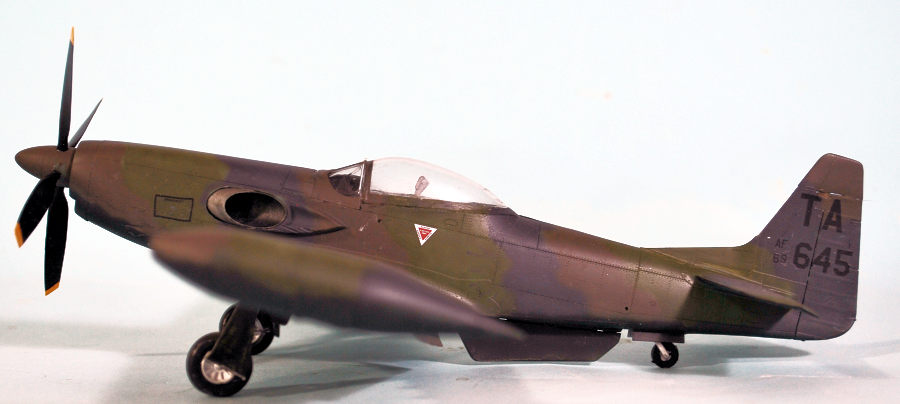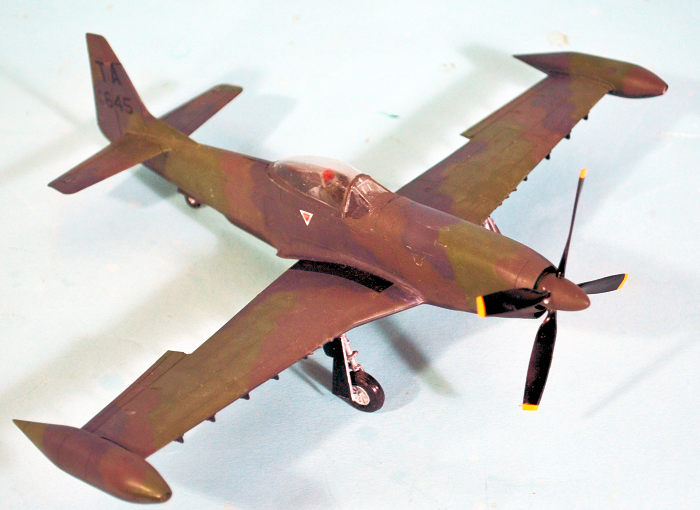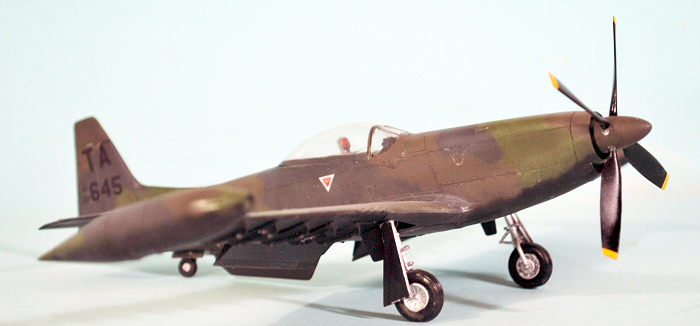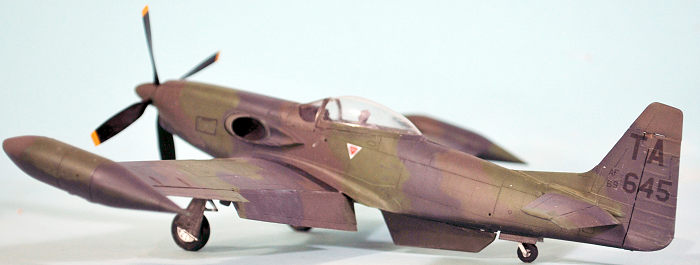
| KIT #: | |
| PRICE: | $55.00 plus donor kit |
| DECALS: | |
| REVIEWER: | Tom Cleaver |
| NOTES: | Eduard donor kit |

| HISTORY |
 Over the years,
many aircraft types have evolved become far more by having their existing piston
engines replaced with turboprop powerplants.Less common is to eimagine a World
War II-era fighter as a modernized, turboprop attack aircraft and market it to
the government. This happened in the form of the Piper PA-48 Enforcer. First
flown in 1971, four prototypes were built and demonstrated until their
retirement in 1984.
Over the years,
many aircraft types have evolved become far more by having their existing piston
engines replaced with turboprop powerplants.Less common is to eimagine a World
War II-era fighter as a modernized, turboprop attack aircraft and market it to
the government. This happened in the form of the Piper PA-48 Enforcer. First
flown in 1971, four prototypes were built and demonstrated until their
retirement in 1984.
The concept of modifying and remanufacturing P-51s began in the 1950s.The National Guard had retired the last active duty examples, and they were available on the open market at bargain prices. Trans Florida Aviation saw a business opportunity.
Their strategy targeted two potential customers: Civilian versions with the military equipment stripped out and replaced with additional fuel tanks and luxurious interiors. Second, modify existing military Mustangs with new avionics and weapons systems, optimizing them for ground attack, close air support, and counter-insurgency missions.
 These Mustangs
were renamed the Cavalier Mustangs; 19 were produced for a variety of civilian
and military customers. In the late 1960s, one had a 1,630 shp Rolls-Royce Dart
510 installed. No sales resulted, but one entity became convinced of the
airplane’s potential.
These Mustangs
were renamed the Cavalier Mustangs; 19 were produced for a variety of civilian
and military customers. In the late 1960s, one had a 1,630 shp Rolls-Royce Dart
510 installed. No sales resulted, but one entity became convinced of the
airplane’s potential.
Piper Aircraft purchased the rights to the turboprop Mustang and continued to develop the concept. Beginning with two Cavalier Mustangs, they installed massive, 2,445 shp Lycoming YT-55-L-9 turboprop engines. The addition of nearly 1,000 horsepower increased capability; this was the same engine used by the CH-47 Chinook helicopter.
Piper also constructed two clean-sheet versions of the aircraft in 1984, with a $12 million appropriation from Congress, giving the new prototypes the designation PA-48. These aircraft were evaluated by the USAF, but flown only by Piper test pilots. All four used a modified Douglas Skyraider propeller. To ease maneuvering at high speeds and low altitudes, the ailerons were equipped with a boost system from a Lockheed T-33, and the rudder was equipped with a yaw damper.
N482PE, the first of two Cavalier Mustangs modified in 1971, has been restored and is on display at the Air Force Flight Test Museum at Edwards Air Force Base in California.
| THE KIT |
Halberd Models is a Ukrainian aftermarket company. They have recently produced conversion sets in 1/48 and 1/32 for the Cavalier Mustang II, the Dart-powered conversion and the 1971 PA-48 prototype. For the PA-48, the full fuselage has the lower scoop removed.
| CONSTRUCTION |
The primary
difference between assembling this kit and a normal Eduard P-51D is that one
leaves out everything in the rear of the cockpit, and replaces that with the
extra seat provided in the kit. The resulting interior is not actually accurate
for a Cavalier Mustang, which had the upgraded interior. Using photos of the
cockpit, the additional changes can be accomplished using Evergre en
sheet.
en
sheet.
The wingtip outboard of the aileron is cut off along the panel line, to mount the wingtip tanks. Additionally, one needs to drill out locating holes for the four additional underwing pylons under each wing; the Halberd instructions provide locating information. The vertical fin and rudder is cut off along the upper panel line, to attach the resin fin extension. Nothing involved in this work is hard to do.
Before joining the fuselage halves, the large exhaust must be glue into position in the right half; the mounting location is keyed to get it right so it will align with the hole when the fuselage is assembled.
The airplane used a canopy diferent in sizer and shape from the standard P-51 canopies in the Eduard kit. I used one of the Squadron vaduform canopies for the F-82 Twin Mustang, since these are not accurate for the new, accurate, Modelsvit kit. I took a kit canopy and cut off the lower frame, and mounted the clear section of the Squadron vacform canopy to it. Since the kit cockpit isn't actually right for the Cavalier Mustang, and I didn't have the information to modify it, I decided to close the canopy.
I attached the underwing pylons, the fin extension, tip tanks and ventral stabilizing fin with CA glue. No filler was necessary anywhere.
| COLORS & MARKINGS |
 I planned
to do this as a “what if” airplane assigned to the Zorros for operational
test in Southeast Asia, and so I painted it in a one-off “night” scheme,
freehanded with two shades of green, dark grey, and black undersides.
Unfortunately, when it came time to fit underwing ordnance, I found nothing
I had would fit with the flap lowered. Oh well...
I planned
to do this as a “what if” airplane assigned to the Zorros for operational
test in Southeast Asia, and so I painted it in a one-off “night” scheme,
freehanded with two shades of green, dark grey, and black undersides.
Unfortunately, when it came time to fit underwing ordnance, I found nothing
I had would fit with the flap lowered. Oh well...
I used spare decals from the ICM Counter-Invader B-26K for markings.
| CONCLUSIONS |
This is an excellent conversion that is easy to do for a modeler who has done other conversions. Nothing is difficult. Highly recommended for P-51 Mustang fans.
10 November 2023 Copyright
ModelingMadness.com. All rights reserved. No reproduction in part or in whole
without express permission. Review kit courtesy of all you book buyers. If you would like your product reviewed fairly and fairly quickly, please
contact
the editor or see other details in the
Note to
Contributors.